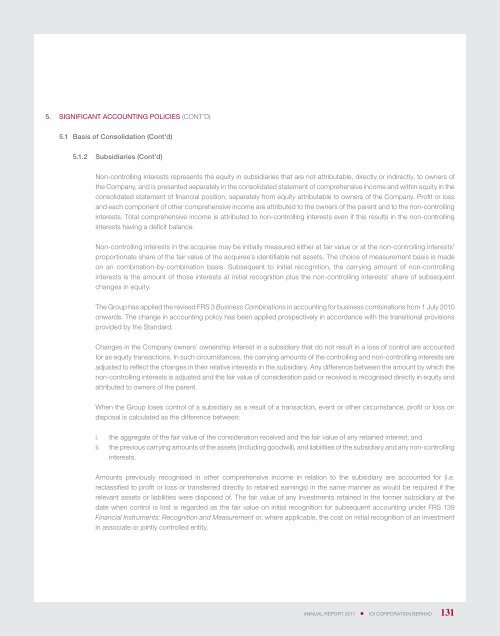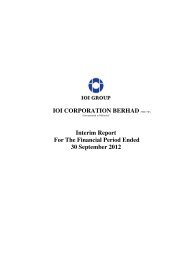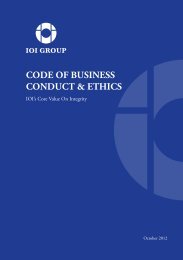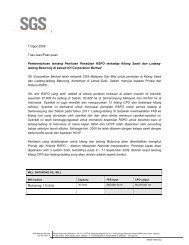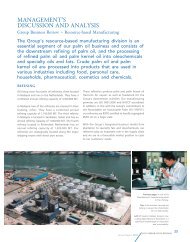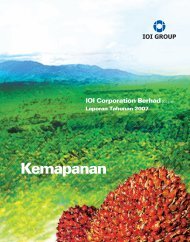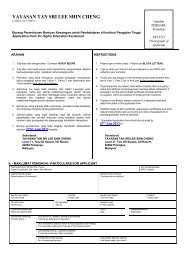Eng - IOI Group
Eng - IOI Group
Eng - IOI Group
Create successful ePaper yourself
Turn your PDF publications into a flip-book with our unique Google optimized e-Paper software.
5. SIGNIFICANT ACCOUNTING POLICIES (cont’d)<br />
5.1 Basis of Consolidation (Cont’d)<br />
5.1.2 Subsidiaries (Cont’d)<br />
Non-controlling interests represents the equity in subsidiaries that are not attributable, directly or indirectly, to owners of<br />
the Company, and is presented separately in the consolidated statement of comprehensive income and within equity in the<br />
consolidated statement of financial position, separately from equity attributable to owners of the Company. Profit or loss<br />
and each component of other comprehensive income are attributed to the owners of the parent and to the non-controlling<br />
interests. Total comprehensive income is attributed to non-controlling interests even if this results in the non-controlling<br />
interests having a deficit balance.<br />
Non-controlling interests in the acquiree may be initially measured either at fair value or at the non-controlling interests’<br />
proportionate share of the fair value of the acquiree’s identifiable net assets. The choice of measurement basis is made<br />
on an combination-by-combination basis. Subsequent to initial recognition, the carrying amount of non-controlling<br />
interests is the amount of those interests at initial recognition plus the non-controlling interests’ share of subsequent<br />
changes in equity.<br />
The <strong>Group</strong> has applied the revised FRS 3 Business Combinations in accounting for business combinations from 1 July 2010<br />
onwards. The change in accounting policy has been applied prospectively in accordance with the transitional provisions<br />
provided by the Standard.<br />
Changes in the Company owners’ ownership interest in a subsidiary that do not result in a loss of control are accounted<br />
for as equity transactions. In such circumstances, the carrying amounts of the controlling and non-controlling interests are<br />
adjusted to reflect the changes in their relative interests in the subsidiary. Any difference between the amount by which the<br />
non-controlling interests is adjusted and the fair value of consideration paid or received is recognised directly in equity and<br />
attributed to owners of the parent.<br />
When the <strong>Group</strong> loses control of a subsidiary as a result of a transaction, event or other circumstance, profit or loss on<br />
disposal is calculated as the difference between:<br />
i. the aggregate of the fair value of the consideration received and the fair value of any retained interest; and<br />
ii. the previous carrying amounts of the assets (including goodwill), and liabilities of the subsidiary and any non-controlling<br />
interests.<br />
Amounts previously recognised in other comprehensive income in relation to the subsidiary are accounted for (i.e.<br />
reclassified to profit or loss or transferred directly to retained earnings) in the same manner as would be required if the<br />
relevant assets or liabilities were disposed of. The fair value of any investments retained in the former subsidiary at the<br />
date when control is lost is regarded as the fair value on initial recognition for subsequent accounting under FRS 139<br />
Financial Instruments: Recognition and Measurement or, where applicable, the cost on initial recognition of an investment<br />
in associate or jointly controlled entity.<br />
annual report 2011 • ioi corporation berhad<br />
131


